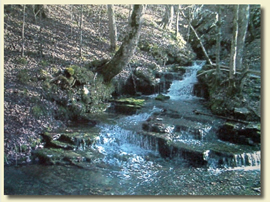Murphy's
Hollow Spring is located on the east side of Murphy's Hollow
Road and a short distance south of Interstate 24. It appears
on the New Home GA/AL/TN quadrangle of the U.S. Geological
Survey maps.

This
beautiful spring, located beside the Murphy's Hollow Road,
was much used during the war. Two divisions of the 14th Army
Corps and all of the 21st Army Corps of the Federal Army of
the Cumberland used this route. Colonel Edward A. King, 2nd
Brigade, 4th Division of the 14th Army Corps was the first
unit in the area. He filed this report on his activities:
"I have the honor to report that, in pursuance of orders,
I crossed the Tennessee River last night with my brigade,
and with 376 men of Second Tennessee Cavalry under Colonel
Ray, who reported to me as directed by Major-General Reynolds.
I sent Colonel Ray in advance, with instructions to proceed
toward Chattanooga and if he could, without exposing his regiment
too much, to go within view of the enemy at Lookout Mountain,
falling back upon my brigade if hard pressed, at the junction
of the Trenton and Chattanooga road [Murphy's Hollow Road
in Whiteside], where I supposed I could be in time. Colonel
Ray carried out his instructions handsomely, driving in the
enemy's pickets at daylight, and approaching within five-gun
battery at Lookout Mountain. He captured an acting rebel commissary
of subsistence, whose saddle-bags I examined and found $2,735.50,
which presuming to be public funds, I took possession of and
will turn it over to order. I left the Trenton road at 9 a.m.
to-day, reaching Shellmound at 2 p.m. The Chattanooga Road
is, in many places, quite bad." |
Scattered
units of the 3rd Confederate Cavalry attempted to slow the
Federal advance. There were several small skirmishes near
the Tennessee River, and the bulk of the 3rd Confederate Cavalry
engaged in a running fight with the Federal 2nd Tennessee
Cavalry that started near the River and continued along Murphy's
Hollow Road almost to Trenton. During this action, the Federals
captured several of the Confederate cavalrymen. Sergeant G.
W. Simms and Private John Webb of Marion County, Tennessee,
along with Arch Thomas of Jackson County, Alabama, were sent
to Rock Island Prison. Jesse Cox and A. J. Gibson died at
Camp Chase prison.
The
divisions commanded by Generals Reynolds and Brannan of General
Thomas' 14th Army Corps of the Army of the Cumberland used
this route to enter Dade County. They were followed by General
Crittenden's 21st Army Corps. At 2:00 A.M. on September 3,
1863 General James A. Garfield, General Rosecrans' Chief of
Staff, issued the following orders to Corps commanders: "The
general commanding announces the following orders for the
movement of the army General Crittenden will move his corps
up the valley of Running Water Creek to Whiteside's where
he will post one regiment, and send one division along the
Nashville and Chattanooga Railroad, to the Trenton road, with
orders to push forward as near to Chattanooga as practicable
and threaten the enemy in that direction. With the remainder
of his force he will occupy a position near the junction of
Muryhy's Valley Road with the road marked on the map as a
good wagon road to Naylor's.' He will hold his train on his
right and rear, and be in readiness to move wither upon Whiteside's,
the Trenton Road, or Shellmound. These movements should be
completed on the evening of September 4."
General
Crittenden, commander of the 21st Army Corps, reported to
Garfield from the junction of Murphy's Hollow and Nickajack
Roads at 9:35 A.M. on September 6. "I have the honor
to inform you that I have just arrived at this point with
General Palmer and his First Brigade, General Van Cleve is
between here and Whiteside's, and will encamp about 2 miles
from here, where there is good water. General Wood had moved
in the direction of Chattanooa." |
"The
general commanding approves the disposition of your forces"
General Garfield replied to Crittenden. "Department headquarters
are fixed at this place [Trenton] for the present." The
road was so congested that several days were required for all
the men to get through. After reaching the Trenton to Chattanooga
Road, Crittenden's Corps turned north and continued on to Chattanooga.
Reyonolds' and Brannan's divisions of Thomas' 14th Army Corps
turned south toward Trenton.
References:
Official Records of the War of the Rebellion
Archive and files Chickamauga and Chattanooga National Military
Park Raymond Evans, The Civil War in Dade County
Significant
Views: A good viewshed for this area exists along
both sides of Murphy's Hollow Road leading south toward Trenton
from the Tennessee State line.
Setting:
The setting is very rural and highly scenic in nature. At
the point where the road leaves Tennessee there are a few
visual intrusions from recent residential developments. Soon,
however, the road passes between wooded mountains on either
side to the site of the spring in an area that has changed
little since the time of the war.
Documented
Structures, Sites and Features: The ruins of the
war time Murphy house are near the road. A beautiful rest
stop can be found at the Murphy Spring on the east side of
the road. Thousands of soldiers paused and camped here during
the Chickamauga Campaign.
Presumed
Wartime Features: This was the major route for troop
movements during the Chickamauga campaign. There are rumors
of Confederate Graves near the spring. These may be casualties
from the cavalry fight at the start of the campaign in this
area.
Original
Terrain: Except for the road being paved, the original
terrain in this area is unchanged from the time when the soldiers
passed through here in September 1863 on their way to Chickamauga.
Related
Sites: Cole's Plantation and Academy.
|